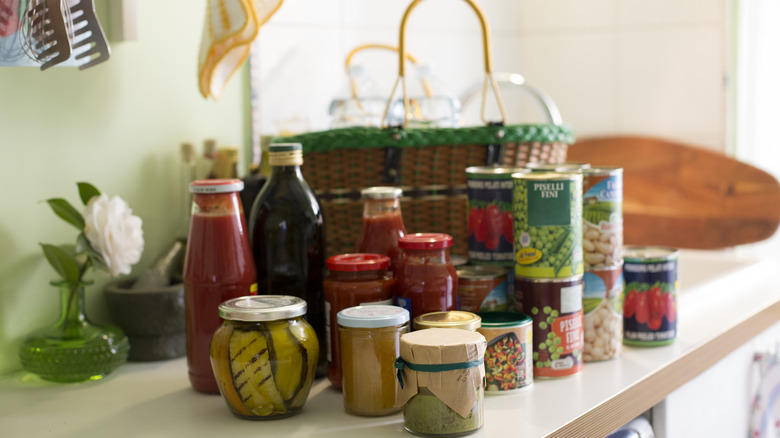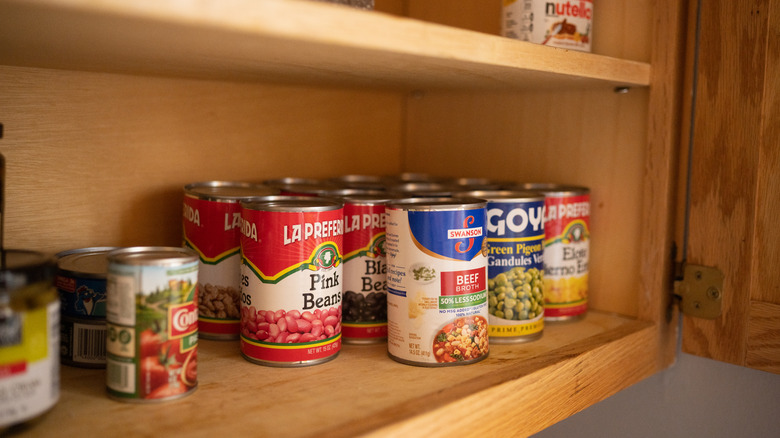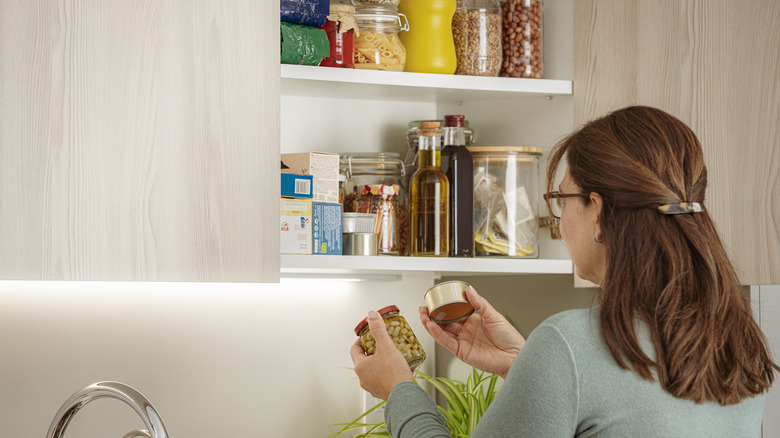The Essential Rules To Follow When Storing Canned Food
Canned food revolutionized the world, changing the way we fuel ourselves and presenting a way to truly preserve food for months and even years on end. Other than refrigeration, no invention changed the game of food preservation more than canning since it was invented back in the early 1800s. What would a grocery store be without aisles of canned goods, and what would a home pantry be without cylinders of tomatoes, beans, veggies, and soups? Indeed, canned goods are a staple thanks to their convenience and lifespan, with many options lasting years and most lasting at least many months – but even with these virtually indestructible foods, there are right and wrong ways to store and care for them.
You might not give that can of corn a second thought once it's unpacked from your grocery haul, but there are indeed ways to make canned goods last even longer while preserving their quality. So while virtually indestructible they may seem, there are limits to this. Namely, it's critical to use storage methods that keep canned food away from high heat or massive temperature fluctuations, safe from being dinged up, and in the case of canned foods in glass jars, away from sunlight. All such exposures can make canned goods go bad much faster, potentially expose you to harmful pathogens, and can diminish nutritional values.
Handle cans with a little TLC
If you've ever heard the advice to steer clear of any dinged up or dented cans, whether from grocery store shelves or from the back of your pantry, this isn't just an old wives' tail — there's truth behind it. While cans are regularly lining the bottom of heavy grocery store totes and winding up stacked in the back of pantries, there is a limit to how much weight they should be subject to. The golden rule for pantry storage of canned foods is to never stack them more than two cans high — any more than this, and the relatively fragile metal can become dented and smushed. As this happens, air can potentially enter the can, creating the possibility for botulism — a scary-sounding word, and for good reason.
By far the largest food safety hazard of consuming canned foods, botulism can occur in any incorrectly sealed can or one that's been damaged. And per the USDA, consuming any trace of this toxin can have deadly consequences. If you have any doubts about the safety of a canned food item, simply toss — botulism is rare but it's never worth the risk. The easy way to avoid this issue is by properly stacking and storing your cans, never piling under too many layers or other heavy items, and generally handling them with some care.
Avoid temperature fluctuations & check expiration dates
The best place bar none for your rows of canned legumes, veggies, and soups is on a dark shelf in your pantry, where their exposure to changes in light and temperature will be minimal. Don't, for example, store your canned stash out in the garage or on a drafty attic floor if you can help it. Both settings invite changes in temps and potential exposure to moisture, which can cause cans to rust and break down. Temperature swings, whether freezing or high heat, are the enemy of long-lasting canned foods. Freezing temps can also cause jars to rust or break, letting air and potential bacteria in, and super high heats make canned food go bad quicker while breaking down their nutritional benefits.
Expiration dates should be observed, always, and in the case of DIY canned goods, always mark the date they were canned so you can keep track of when it's time to toss. With these proper storage tips, and a little thoughtfulness on which canned foods to always keep in your pantry and which to pass on, you'll never be without ample emergency supplies — be it for bad weather, natural disasters, or simply when the craving for rice and beans or a comforting tomato soup strikes.


